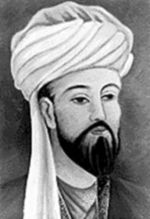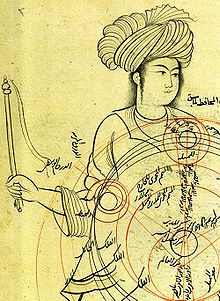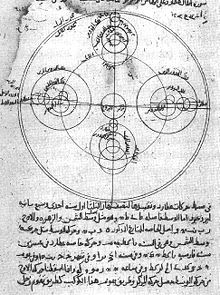- Maragheh observatory
-
Maragheh observatory (Persian:رصدخانه مراغه) is an astronomical observatory which was established in 1259 CE by Nasir al-Din al-Tusi, an Iranian scientist and astronomer. Located in the heights west of Maragheh, East Azarbaijan province, Iran, it was once considered one of the most prestigious observatories in the world.[citation needed]
Contents
Description
Considerable parts of the groundwork are preserved in the ruins. In a 340 to 135 m² citadel-like area stood a four-story circular stone building of 28 m diameter. The mural quadrant to observe the positions of the stars and planets was aligned with the meridian. This meridian served as Prime meridian for the tables in the Zij-i Ilkhani, as we nowadays apply the meridian which passes the Royal Greenwich Observatory.
The Maragha observatory was the largest observatory in its time, consisting of a series of buildings occupying an area of 150 metres in width and 350 metres in length. One of these buildings was a dome which allowed the sun's rays to pass through.[1] There was also a library consisting of 40,000 volumes,[2] which were plundered from other libraries by the Mongol Empire during its invasions across Persia, Syria and Mesopotamia. Astronomers from across Persia, Syria, Anatolia and even China were gathered at the observatory, and the names of at least twenty of them who worked at the observatory are known. It is believed that several Chinese astronomers worked at the observatory and that they introduced several Chinese methods of computation. The Maragha observatory was also reported to have had over a hundred students studying under Nasir al-Din Tusi at the observatory, and was also the first observatory to benefit from the revenues of waqf trust funds. After al-Tusi's death, his son was appointed the director of the institution, but it was later abandoned by the middle of the 14th century. A visit to the ruins of the observatory later inspired Ulugh Beg to construct his own large observatory at Samarkand to continue the astronomical research of the Maragha school from where it left off.[1]
History
Hulegu Khan believed that many of his military successes were due to the advice of astronomers (who were also astrologers), especially of Nasīr al-Dīn al-Tūsī. Therefore when Tusi complained that his astronomical tables were outdated, Hulagu gave a permission to build a new observatory in a place of Tusi's choice. According to books like Jam-e-ttavarikhe rashidi (Persian: جامع التواريخ رشيدي), saf-e-elhofreh (Persian: صاف الحفره), favat-o-lvafiyyat (Persian: فوات الوفيات) the building of the rasad khaneh started in 1259 (657 A.H.). The library of the observatory contained 40,000 books on many subjects, related to astrology/astronomy as well as other topics. Bar-Hebraeus late in his life took residence close to the observatory in order to use the library for his studies. He has left a description of the observatory.
A number of other prominent astronomers worked with Tusi there, such as Muhyi al-Din al-Maghribi, Mu'ayyid al-Din al-'Urdi, from Damascus, and Qutb al-Din al-Shirazi. The observatory also attracted scholars from beyond the Islamic world, such as Hulagu's Chinese astronomer Fao Munji, whose Chinese astronomical experience brought further improvements to the Ptolemaic system initially used by Tusi. It also attracted scholars from the Byzantine Empire, most notably Gregory Choniades, who studied under Shams ad-Din al-Bukhari, an astronomer who worked at the famous observatory under al-Tusi. Choniades later translated the Zij-i Ilkhani, compiled at the observatory, into Byzantine Greek and took it to the Byzantine Empire. He may have been responsible for the transmission of the Tusi-couple to Europe, where it eventually influenced Copernican heliocentrism.[3]
For his planetary models, Tusi invented a geometrical technique called a Tusi-couple, which generates linear motion from the sum of two circular motions. He also determined the precise value of 51 arcsec for the annual precession of the equinoxes and contributed to the construction and usage of some astronomical instruments including the astrolabe.
And after 12 years of intense work by Khaje Nassir od-Din Tussi and the other prominent scientists the observations and planetary models were compiled in the Zij-i Ilkhani, which later still influenced Copernicus. The tables were published during the reign of Abaqa Khan, Hulagu's son, and named after the patron of the observatory. They were popular until the 15th century.
It is not known with certainty until when it had been active. It turned into ruins as a result of frequent earthquakes and lack of funding by the state. Shah Abbas the Great arranged for repair, however, this was not commenced due to the king's early death.
The remains inspired Ulugh Beg to construct his observatory in Samarkand in 1428.
Hulegu's older brother, Khublai Khan also constructed an observatory, the Gaocheng Astronomical Observatory in China.
A star globe from the observatory made in 1279 is now preserved in Dresden, Germany. It is a rare example of decorative art from Iran of the 13th century, designed by M. Ordi and made of bronze, inlaid with silver and gold.
Maragha Revolution
See also: Islamic astronomy Nasir al-Din al-Tusi resolved significant problems in the Ptolemaic system with the Tusi-couple, which later played an important role in the Copernican model.
Nasir al-Din al-Tusi resolved significant problems in the Ptolemaic system with the Tusi-couple, which later played an important role in the Copernican model.
The "Maragha Revolution" refers to the Maragheh school's revolution against Ptolemaic astronomy. The "Maragha school" was an astronomical tradition beginning in the Maragheh observatory and continuing with astronomers from the Damascus mosque and Samarkand observatory. The Maragha astronomers attempted to solve the equant problem and produce alternative configurations to the Ptolemaic model. They were more successful than previous astronomers in producing non-Ptolemaic configurations which eliminated the equant and eccentrics, were more accurate than the Ptolemaic model in numerically predicting planetary positions, and were in better agreement with empirical observations.[4] The most important of the Maragha astronomers included Mo'ayyeduddin Urdi (d. 1266), Nasīr al-Dīn al-Tūsī (1201–1274), Najm al-Dīn al-Qazwīnī al-Kātibī (d. 1277), Qutb al-Din al-Shirazi (1236–1311), Sadr al-Sharia al-Bukhari (c. 1347), Ibn al-Shatir (1304–1375), Ali Qushji (c. 1474), al-Birjandi (d. 1525), and Shams al-Din al-Khafri (d. 1550).[5]
Some have described their achievements in the 13th and 14th centuries as a "Maragha Revolution", "Maragha School Revolution", or "Scientific Revolution before the Renaissance". An important aspect of this revolution included the realization that astronomy should aim to describe the behaviour of physical bodies in mathematical language, and should not remain a mathematical hypothesis, which would only save the phenomena. The Maragha astronomers also realized that the Aristotelian view of motion in the universe being only circular or linear was not true, as the Tusi-couple showed that linear motion could also be produced by applying circular motions only.[6]
Unlike the ancient Greek and Hellenistic astronomers who were not concerned with the coherence between the mathematical and physical principles of a planetary theory, Islamic astronomers insisted on the need to match mathematics with the real world surrounding them, which gradually evolved from a reality based on Aristotelian physics to one based on an empirical and mathematical physics.[7] The Maragha Revolution was thus characterized by a shift away from the philosophical foundations of Aristotelian cosmology and Ptolemaic astronomy and towards a greater emphasis on the empirical observation and mathematization of astronomy and of nature in general, as exemplified in the works of Ibn al-Shatir, Ali Qushji, al-Birjandi and al-Khafri.[8][9]
Other achievements of the Maragha school include the first empirical observational evidence for the Earth's rotation on its axis by Tusi and Qushji,[10] the separation of natural philosophy from astronomy by Ibn al-Shatir and Qushji,[10] the rejection of the Ptolemaic model on empirical rather than philosophical grounds by Ibn al-Shatir,[4] and the development of a non-Ptolemaic model by Ibn al-Shatir that was mathematically identical to the heliocentric Copernical model.[11]
 Medieval manuscript by Qutb al-Din al-Shirazi depicting an epicyclic planetary model.
Medieval manuscript by Qutb al-Din al-Shirazi depicting an epicyclic planetary model.
Mo'ayyeduddin Urdi (d. 1266) was the first of the Maragheh astronomers to develop a non-Ptolemaic model, and he proposed a new theorem, the "Urdi lemma".[12] Nasir al-Din al-Tusi (1201–1274) resolved significant problems in the Ptolemaic system by developing the Tusi-couple as an alternative to the physically problematic equant introduced by Ptolemy.[13] Tusi's student Qutb al-Din al-Shirazi (1236–1311), in his The Limit of Accomplishment concerning Knowledge of the Heavens, discusses the possibility of heliocentrism. Al-Qazwīnī al-Kātibī, in his Hikmat al-'Ain, wrote an argument for a heliocentric model, though he later abandoned the idea.[14]
 Ibn al-Shatir's model for the appearances of Mercury, showing the multiplication of epicycles using the Tusi-couple, thus eliminating the Ptolemaic eccentrics and equant.
Ibn al-Shatir's model for the appearances of Mercury, showing the multiplication of epicycles using the Tusi-couple, thus eliminating the Ptolemaic eccentrics and equant.
Ibn al-Shatir (1304–1375), in his A Final Inquiry Concerning the Rectification of Planetary Theory, eliminated the need for an equant by introducing an extra epicycle, departing from the Ptolemaic system in a way very similar to what Nicolaus Copernicus later also did. Ibn al-Shatir proposed a system that was only approximately geocentric, rather than exactly so, having demonstrated trigonometrically that the Earth was not the exact center of the universe. Unlike previous astronomers before him, Ibn al-Shatir was not concerned with adhering to the theoretical principles of natural philosophy (or Aristotelian physics), but rather to produce a model that was more consistent with empirical observations. For example, it was Ibn al-Shatir's concern for observational accuracy which led him to eliminate the epicycle in the Ptolemaic solar model and all the eccentrics, epicycles and equant in the Ptolemaic lunar model. His model was thus in better agreement with empirical observations than any previous model produced before him. While previous Maragha models were just as accurate as the Ptolemaic model, Ibn al-Shatir's geometric model was the first that was actually superior to the Ptolemaic model in terms of its better agreement with empirical observations. His work thus marked a turning point in astronomy, which may be considered a "Scientific Revolution before the Renaissance".[4]
Y. M. Faruqi wrote:[15]
"Ibn al-Shatir’s theory of lunar motion was very similar to that attributed to Copernicus some 150 years later"."Whereas Ibn al-Shatir’s concept of planetary motion was conceived in order to play an important role in an earth-centred planetary model, Copernicus used the same concept of motion to present his sun-centred planetary model. Thus the development of alternative models took place that permitted an empirical testing of the models."Ibn al-Shatir’s rectified model, which included the Tusi-couple and Urdi lemma, was later adapted into a heliocentric model by Copernicus,[13] which was mathematically achieved by reversing the direction of the last vector connecting the Earth to the Sun in Ibn al-Shatir's model.[16]
An area of active discussion in the Maragheh school, and later the Samarkand and Istanbul observatories, was the possibility of the Earth's rotation. Supporters of this theory included Nasir al-Din al-Tusi, Nizam al-Din al-Nisaburi (c. 1311), al-Sayyid al-Sharif al-Jurjani (1339–1413), Ali Qushji (d. 1474), and Abd al-Ali al-Birjandi (d. 1525). Tusi was the first to present empirical observational evidence of the Earth's rotation, using the location of comets relevant to the Earth as evidence, which Qushji elaborated on with further empirical observations while rejecting Aristotelian natural philosophy altogether. Both of their arguments were later described again by Nicolaus Copernicus in 1543.[17]
Current status
To save the installation from further destruction, Cultural Heritage Organization of Iran built a dome-framed shelter and it plans to hold an exhibit of astronomical devices used at Maragheh observatory.
The observatory is currently covered with a dome-framed brass structure and is situated two miles west of Maragheh.
Notes
- ^ a b Micheau, Francoise, "The Scientific Institutions in the Medieval Near East", pp. 991–2, in (Morelon & Rashed 1996, pp. 1002–1005 [1003])
- ^ Ahmad, I. A. (June 3, 2002), "The Rise and Fall of Islamic Science: The Calendar as a Case Study" (PDF), Faith and Reason: Convergence and Complementarity, Al Akhawayn University, http://images.agustianwar.multiply.com/attachment/0/RxbYbQoKCr4AAD@kzFY1/IslamicCalendar-A-Case-Study.pdf, retrieved 2008-01-31
- ^ Joseph Leichter (June 27, 2009). "The Zij as-Sanjari of Gregory Chioniades". Internet Archive. http://www.archive.org/details/TheZijAs-sanjariOfGregoryChioniades. Retrieved 2009-10-02.
- ^ a b c George Saliba (1994), A History of Arabic Astronomy: Planetary Theories During the Golden Age of Islam, p. 233-234, 240. New York University Press, ISBN 0814780237.
- ^ Dallal (1999), pg. 171
- ^ George Saliba (1994), A History of Arabic Astronomy: Planetary Theories During the Golden Age of Islam, p. 245, 250, 256-257. New York University Press, ISBN 0814780237.
- ^ Saliba, George (Autumn 1999), "Seeking the Origins of Modern Science?", BRIIFS 1 (2), http://www.riifs.org/review_articles/review_v1no2_sliba.htm, retrieved 2008-01-25
- ^ (Saliba 1994b, pp. 42 & 80)
- ^ Dallal, Ahmad (2001–2002), The Interplay of Science and Theology in the Fourteenth-century Kalam, From Medieval to Modern in the Islamic World, Sawyer Seminar at the University of Chicago, http://humanities.uchicago.edu/orgs/institute/sawyer/archive/islam/dallal.html, retrieved 2008-02-02
- ^ a b F. Jamil Ragep (2001), "Freeing Astronomy from Philosophy: An Aspect of Islamic Influence on Science", Osiris, 2nd Series, Vol. 16, p. 49-64, 66-71.
- ^ George Saliba (1994), A History of Arabic Astronomy: Planetary Theories During the Golden Age of Islam, p. 254, 256-257. New York University Press, ISBN 0814780237.
- ^ George Saliba (1979). "The First Non-Ptolemaic Astronomy at the Maraghah School", Isis 70 (4), p. 571-576.
- ^ a b M. Gill (2005). Was Muslim Astronomy the Harbinger of Copernicanism?
- ^ A. Baker, L. Chapter (2002)
- ^ Y. M. Faruqi (2006). "Contributions of Islamic scholars to the scientific enterprise", International Education Journal 7 (4), p. 395-396.
- ^ Saliba (1999).
- ^ F. Jamil Ragep (2001), "Tusi and Copernicus: The Earth's Motion in Context", Science in Context 14 (1-2), p. 145–163. Cambridge University Press.
References
- A. Baker and L. Chapter (2002), "Part 4: The Sciences". In M. M. Sharif, "A History of Muslim Philosophy", Philosophia Islamica.
- Richard Covington (May–June 2007). "Rediscovering Arabic science", Saudi Aramco World, p. 2-16.[unreliable source?]
- Ahmad Dallal, "Science, Medicine and Technology.", in The Oxford History of Islam, ed. John Esposito, New York: Oxford University Press, (1999).
- Morelon, Régis; Rashed, Roshdi (1996), Encyclopedia of the History of Arabic Science, 3, Routledge, ISBN 0415124107
- George Saliba (1999). Whose Science is Arabic Science in Renaissance Europe? Columbia University.
External links
- Maragheh observatory at Iranian Cultural Heritage Organization Documentation Center
- Scientists who made a difference
- Research Institute for Astronomy and Astrophysics of Maragha
- On Maragheh observatory at RIAAM
- Contribution by Parviz Tarikhi with illustrations
- Inside the protecting dome
- Copy of the celestial globe
- Al-Urdi's Article on 'The Quality of Observation', FSTC Limited
Coordinates: 37°23′45.88″N 46°12′32.97″E / 37.3960778°N 46.2091583°E
 East Azerbaijan Province
East Azerbaijan ProvinceCapital 
Counties and Cities Ahar · HurandAjab Shir CountyAjab Shir · KhezerluBonabBostanabad · Tekmeh DashQarah AghajHeris CountyKaleybar CountyKaleybar · Abish AhmadKhoda Afarin CountyKhomarluMalekan · LeylanMaragheh · KharajuVarzaqan · KharvanaLandmarks
and
SightsAmir Nezam House • Arasbaran • Arg of Tabriz • Azerbaijan Museum • Babak Fort • Bazaar of Tabriz • Blue Mosque, Tabriz • Eynali • Quri-gol • Haidar Zadeh house • House of constitution • Iron Age museum • Jamee mosque of Tabriz • Kandovan • Khodaafarin Bridges • Maqbaratoshoara • Maragheh observatory • Museum of Ostad Bohtouni • Saint Stepanos Monastery • Shah-goli • Tabriz Municipality • Zahhak CastleCategories:- 1260s
- History of Iran
- Astronomical observatories in Iran
- Astronomical observatories of medieval Islam
- East Azerbaijan Province
Wikimedia Foundation. 2010.


